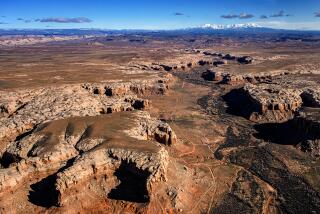Editorial: A moment of bipartisanship in Congress could mean good news for conservation
When members of the House of Representatives return from the February break next week, something unusual will be waiting for them: a sweeping, 662-page bipartisan package of 110 proposals the Senate approved last week — by an overwhelming 92-8 vote — that would protect more than 1.3 million acres of newly designated national wilderness from most development, permanently reauthorize the Land and Water Conservation Fund, create four new national monuments, increase Death Valley National Park by 35,000 acres, and modernize wildfire fighting technologies, among other things.
For all the good things contained in the Natural Resources Management Act, it is most surprising for its scope and for the stunning breadth of bipartisan support it received in a Senate that has been hopelessly divided on just about every important business that comes before it. In that regard, the act’s passage feels like a flashback to the days of horse-trading, back-scratching and compromise that traditionally moved legislation forward.
And so, of course, there is a little bit of something for nearly every state. Beyond the expansion of Death Valley, California would also get, among other things, a 353-acre national monument at the site of the former St. Francis Dam north of Santa Clarita (which collapsed in 1928, killing more than 500 people), and additional wilderness protections in the deserts as well as expanded recreation areas for off-road vehicles.
Making the fund permanent is the right move, though the bill doesn’t go quite far enough.
This is a good collection of initiatives that also has drawn widespread support from conservation groups, though it is far from perfect. No bill this sweeping could be.
The measure would make permanent the Land and Water Conservation Fund, which previously had to be re-authorized every few years. The program, which lapsed due to congressional inaction last year, uses revenues from oil and gas leases on the Outer Continental Shelf to acquire and support public lands and outdoor recreation.
Making the fund permanent is the right move, though the bill doesn’t go quite far enough because it wouldn’t require the revenues actually to be spent for the intended purpose. Only half of about $40 billion raised since 1965 has been spent on conservation efforts; Congress has redirected the rest for other uses. That’s a bad history, given the $30 billion in deferred maintenance and other needs in national parks and protected areas that advocates say have gone unaddressed. And although the measure offers a reliable revenue stream, it overlooks the point that it is in the nation’s — and the world’s — long-term interest to stop drilling and burning oil, so Congress may eventually have to find a fresh source of money as the wells go dry or offline.
The larger measure also raises some lesser questions. One bill sets aside federal land in Alaska for allotment to native Alaskans who served in the Vietnam War. Without getting into whether such a policy is appropriate, why limit it to Alaska? Why not set aside land for veterans in other states? But all in all, this is a good, wide-ranging package, and the House ought to take it up quickly and send it along without controversy to the president, who should sign it.
The package also is notable for what’s not in it.
Enter the Fray: First takes on the news of the minute »
In the Antiquities Act of 1906, Congress shared with the president its authority to designate federal lands for protection as national monuments. The law was intended to increase the government’s flexibility in dealing with fast-moving threats from real estate developers or mining operators, who might stake their claims faster than Congress could push through a new monument designation.
But President Trump last year asserted authority under the Antiquities Act to slash the amount of land covered by two established monuments in Utah, Bears Ears (originally designated by President Obama) and Grand Staircase-Escalante (by President Clinton). The president’s decision rightfully drew howls from conservationists and legal challenges on the grounds that while the act gives the president authority to designate monuments, it contains no language enabling him to undo a designation — because doing so would have defeated the purpose of the law.
Other presidents have made much smaller tweaks to designated monuments, but the right to do so has, until now, never been tested in court. More than 100 lawmakers have proposed a bill (the Antiquities Act of 2019) to make it clear that only Congress has the authority to amend national monument designations, even those made by the president. The Senate could have included that language in the Natural Resources Management Act, but since it didn’t, lawmakers ought to update the Antiquities Act to clarify the issue.
Follow the Opinion section on Twitter @latimesopinion or Facebook
More to Read
A cure for the common opinion
Get thought-provoking perspectives with our weekly newsletter.
You may occasionally receive promotional content from the Los Angeles Times.






